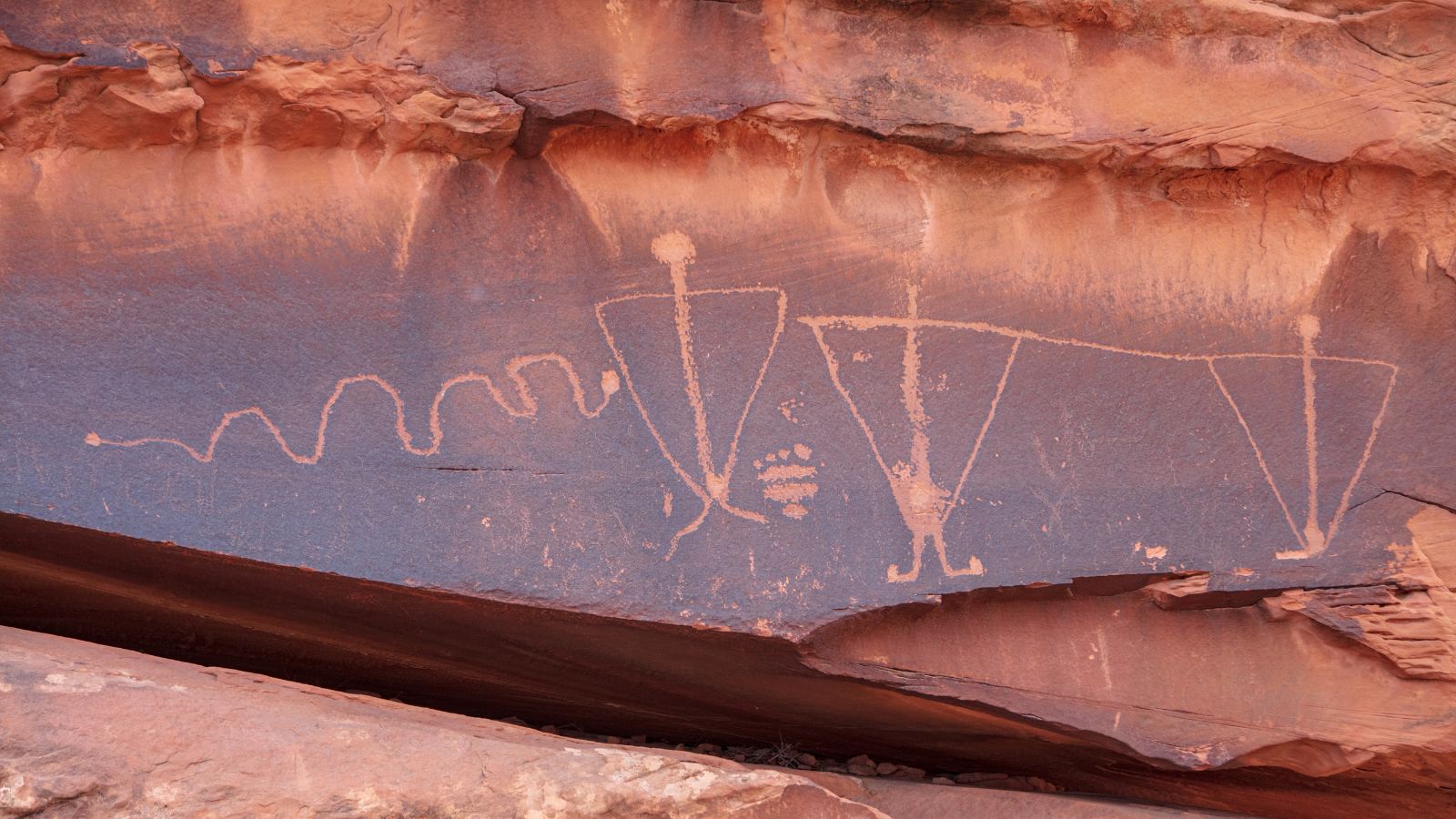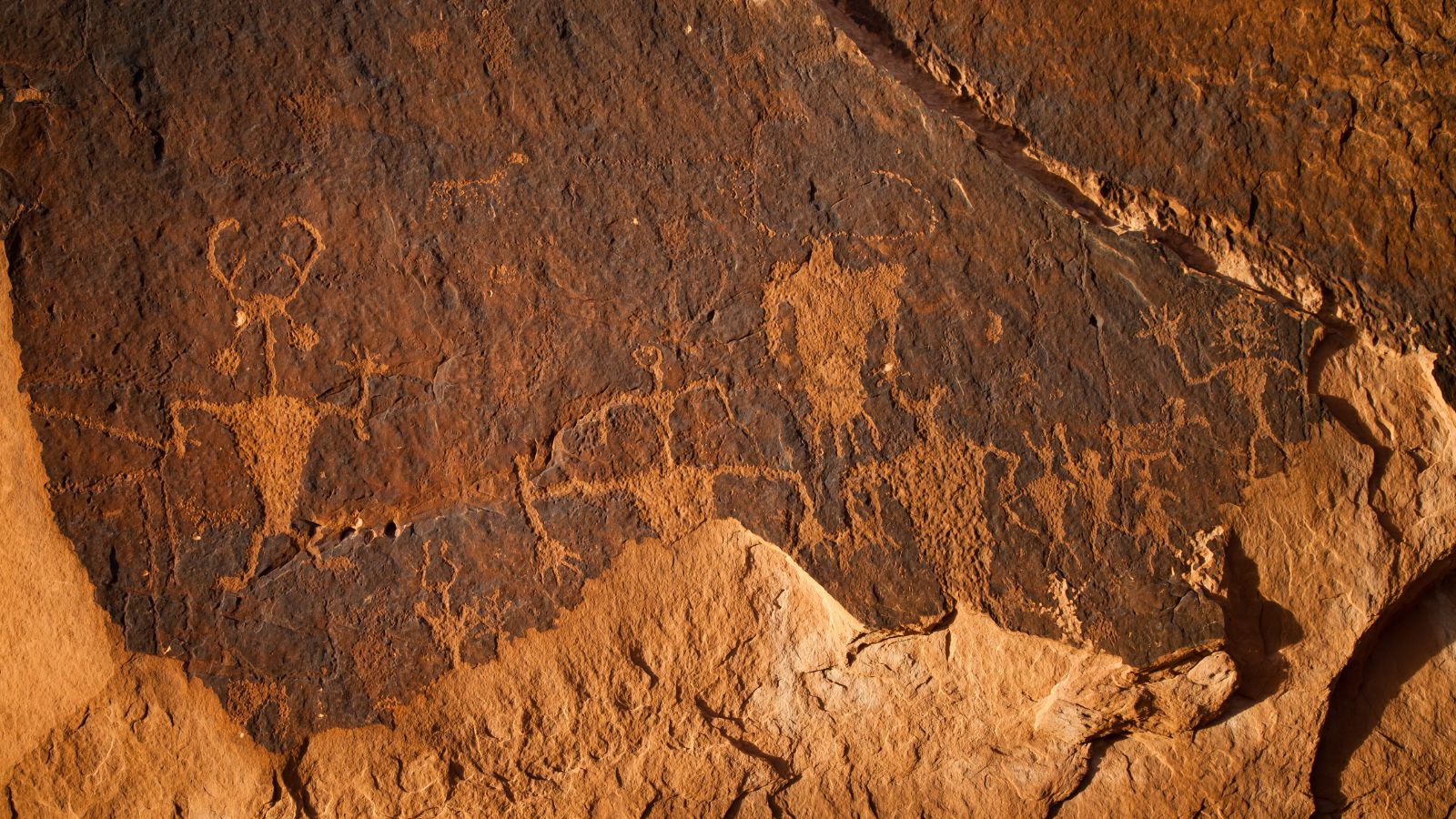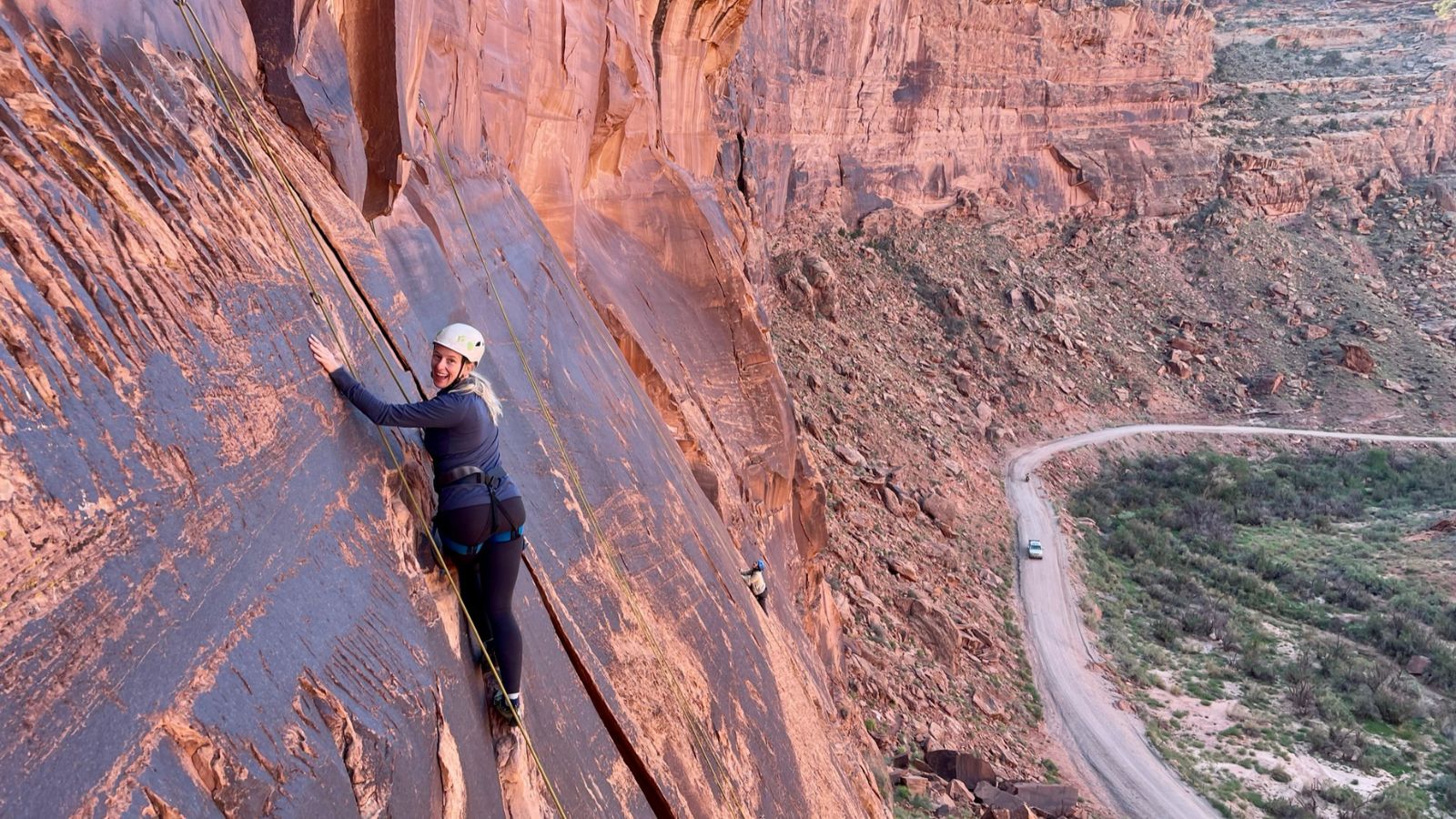Some Of The Best Petroglyphs In Moab
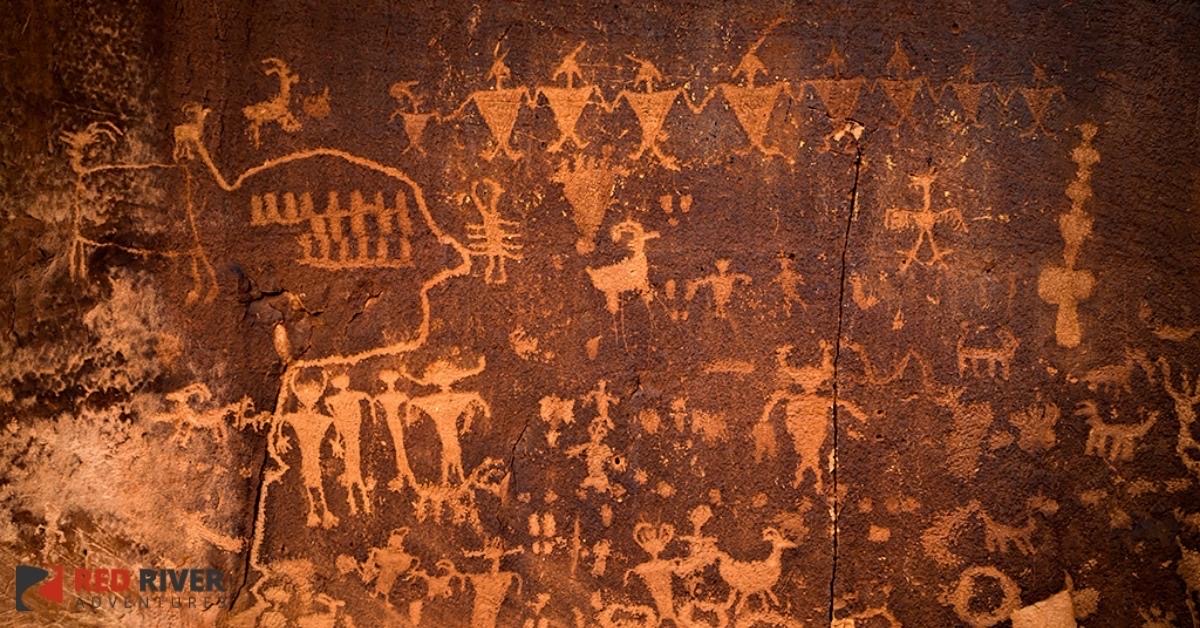
Moab petroglyphs are among the most fascinating ancient artworks in the canyonlands of southern Utah. Moab is a gateway to incredible adventures, including exploring the area’s rich collection of rock art, some of which dates back to 5500 BC. At Red River Adventures, our expert guides have spent years exploring the region’s canyons, rivers, and cultural sites—we know this landscape inside and out. Many of our Moab canyoneering tours include close-up views of ancient petroglyphs, insights into their history, and access to hidden panels few visitors ever see. Here’s a look at some of the most popular rock art sites and where to find petroglyphs in and around Moab.
The Best Petroglyphs in Moab
- Potash Road Petroglyphs
- Moonflower Canyon Petroglyphs
- Birthing Rock Petroglyphs
- Golf Course Petroglyphs (Moab Man)
- Gold Bar Petroglyphs
- Courthouse Wash Pictographs
1. Potash Road Petroglyphs
The large area of cliff wall by the Colorado River along Potash Road is where you’ll find the Potash Road Petroglyphs. You’ll find petroglyphs scattered along the cliff. Some are up high, others are low to the ground. Don’t forget to look behind the vegetation and in the numerous, smaller, alcoves that punctuate the main cliff.
-
- Location: (About 10 miles from Moab) Take US 191 north, to UT 279 south. The rock art and cliff will be on the right. There is signage for the Petroglyphs which are just past the Wall Street rock climbing area.
- Time: For this site, allow an hour, or 1-2 hours if you want to see nearby sites too.
- Trail Length: You can view these spectacular, vivid petroglyphs from your car.
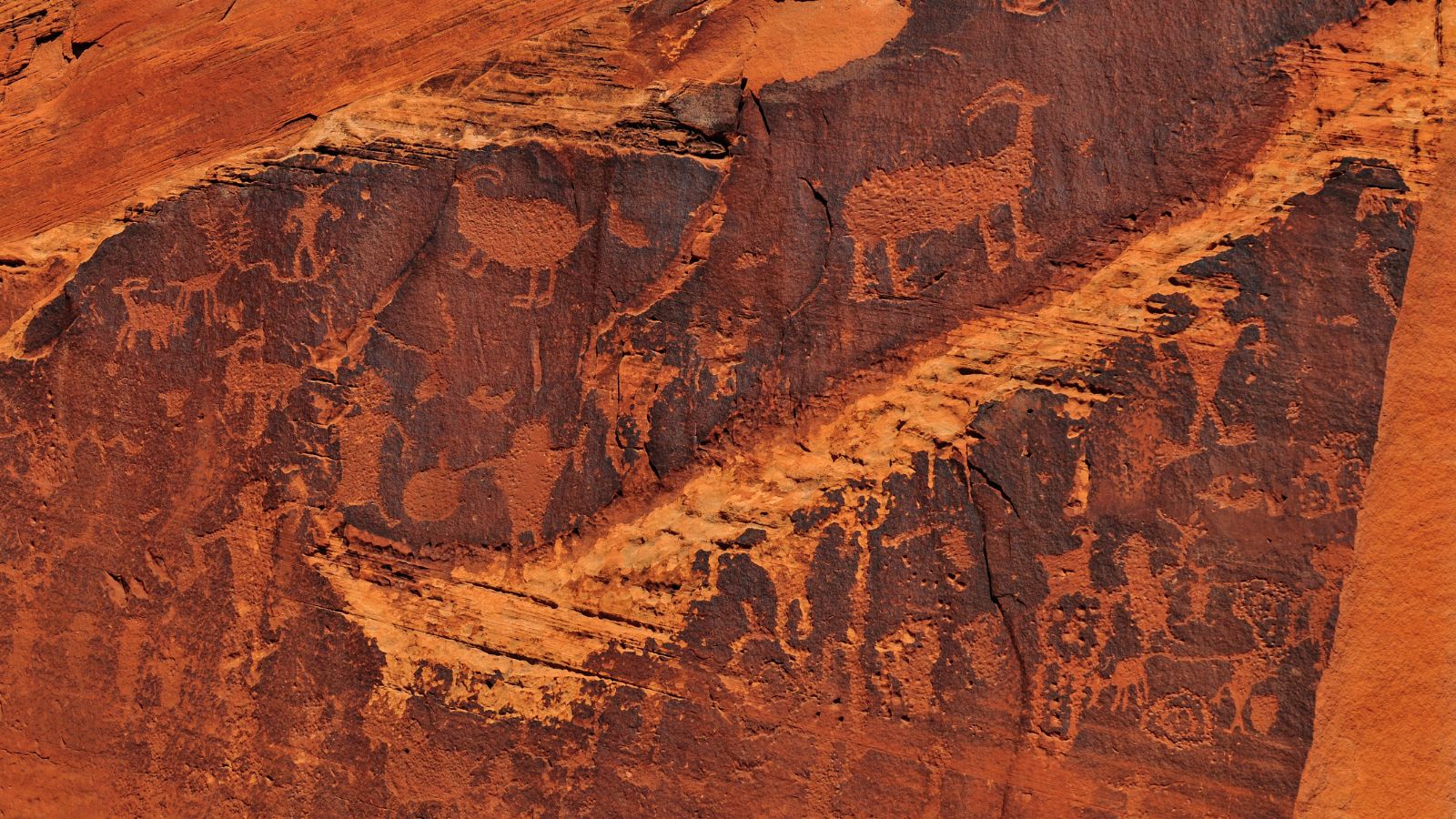
2. Moonflower Canyon Petroglyphs
These petroglyphs are well worth the effort to stop by and see, and they’re convenient to reach as you’re on your way from Moab to visit Birthing Rock. The Moonflower Canyon Petroglyphs are on a small area of the cliff wall right beside the road, so you don’t need to hike into the canyon to see them.
-
- Location: (About 3.3 miles from Moab) Off of Hwy 191 turn onto Kane Creek Blvd. Follow the road west the petroglyphs are on the left, beside the Moonflower Canyon campgrounds.
- Time: Plan for an hour, or a bit longer if you want to hike a little into the Canyon too.
- Trail Length: No hiking is necessary. The rock art is by the parking lot for entering the canyon.
3. Birthing Rock Petroglyphs
The Birthing Rock panel is on a large boulder beside Kane Creek Boulevard. Its namesake petroglyph depicts a woman giving birth to a baby. This is one of, only a handful of “birthing scenes” found in the southwest. It’s one of Moab’s most unique ancient rock artworks.
-
- Location: (About 6.3 miles from Moab) Take Kane Creek Blvd west and continue onto the dirt road after crossing the cattle guard. Continue 1.4 miles on the gravel road to the pull-out on the west side, and walk about 75 feet west downhill to the big boulder with the rock art.
- Time: About 1 to 2 hours to include other stops.
- Trail Length: 150 feet, an easy walk from parking to the boulder.
4. Golf Course Petroglyphs (Moab Man)
The Golf Course Petroglyphs feature Moab Man, a triangular-shaped figure with stunning earrings. There are similar figures of varying sizes, as well as, other figures. These are behind a fence, but this convenient site offers Moab’s most accessible petroglyphs.
-
- Location: (About 5.9 miles from Moab) Take US 191 south. Go left on E Spanish Trail Rd to Westwater Dr. Go about a mile. Pass through the residential area outside the golf course. The petroglyphs are on the left.
- Time: Probably best to allow at least 30 to 45 minutes, including driving time.
- Trail Length: There’s no hiking involved. Just park and walk a few feet to the fence for viewing.
5. Gold Bar Petroglyphs
Some of these fascinating images are nearly identical to those at the Indian Creek Recreation Area nearly 35 miles away. Many are faded and it’s sometimes hard to figure out what you are viewing. Additionally this site has been vandalized by recent visitors. Much of the art has been impacted by graffiti but this site is still worth a visit.
-
- Location: (About 14 miles from Moab) Take US 191 north about 4.1 miles to UT 279 S. The petroglyphs are on the left near the Gold Bar Group Campground. They’re along the north side of the railroad tracks across just inside the entry to Dragonfly Canyon.
- Time: Allow around 30 minutes for a short easy walk and time to view the rock art.
- Trail Length: From the (unmarked) Gold Bar Trailhead it’s about 0.3 miles roundtrip.
6. Courthouse Wash Pictographs
This rock art site is a bit different as you’ll be viewing Pictographs which are paintings rather than petroglyphs which are carvings. The site features images of humans, shields, sheep, dogs, birds, and various abstract shapes painted or carved on the rock. There are also small petroglyphs carved into nearby boulders at the cliff bases. The large figures of the Courthouse Wash Pictographs are believed to be from, 5,000 – 750 B.C. This is an official national historical site.
-
- Location: (About 3 miles from Moab) Take US 191 north to the gravel path of the Courthouse Wash Rock Art Trail, and walk east to the cliff bases. Look up to see the faint petroglyphs. (If you reach Courthouse Wash, you’ve gone too far.)
- Time: Allow about 45 minutes.
- Trail Length: Walk uphill for a short distance of about 500 feet to the base of the cliffs.
Things to Keep In Mind When Visiting Rock Art & Ruins
You’ve come to Moab to enjoy the scenery, discover the many fascinating petroglyphs and pictographs and experience the multitude of exciting things to do near Moab including Moab rafting and so much more!
Please remember to be careful with these ancient cultural treasures:
-
- Don’t touch the petroglyphs or pictographs because fingers have natural oils that contribute to the degradation of rock art.
- If you find an artifact, don’t take it. Just leave it where it is and just take pictures of it.
- If there are rooms or other structures, don’t enter unless it’s posted that it’s allowed.
- Do NOT write on, draw on, paint, or carve the rocks!
Common Questions About Moab Petroglyphs
-
What is the difference between petroglyphs and pictographs?
-
Petroglyphs are carvings or engravings on rock surfaces. They’re made by chipping, pecking, or scratching into the stone. Pictographs are paintings or drawings on rock surfaces, usually made with natural pigments like charcoal, ochre, or minerals.
-
-
What is the largest petroglyph in Utah?
-
The largest known rock art panel in Utah is the Great Gallery in Horseshoe Canyon, part of Canyonlands National Park. It stretches about 200 feet long and up to 15 feet high, featuring life-sized, ghostlike human figures in the Barrier Canyon Style. These figures are believed to have been created between 2000 BCE and 500 CE by Desert Archaic people . Other notable petroglyph sites include Nine Mile Canyon—nicknamed “the world’s longest art gallery”—and Newspaper Rock near Moab, which features a dense mix of images from multiple Indigenous cultures.
-
-
Who made the petroglyphs in Utah?
-
Several Indigenous cultures contributed to Utah’s rich rock art legacy:
-
Desert Archaic people (approx. 2000 BCE–500 CE) – Created Barrier Canyon Style art, including the Great Gallery .
-
Fremont culture (approx. 300–1300 CE) – Known for trapezoidal human figures and abstract symbols .
-
Ancestral Puebloans (approx. 200–1300 CE) – Produced geometric designs and stylized depictions of daily life.
-
Ute people (from ~1300 CE to present) – Created more recent petroglyphs, often depicting horses and riders after European contact.
-
-
-
How old are Moab petroglyphs?
-
The petroglyphs around Moab range in age from around 700 to over 2,000 years old. Many are attributed to the Fremont people (300–1300 CE) , while others are Ute carvings from more recent centuries. Some sites even include Archaic-era rock art, dating back more than 3,000 years.
-
Red River Adventures offers some of the most exciting and immersive guided experiences in the Moab area. Many of our canyoneering tours include close-up views of ancient petroglyphs, insights into their history, and access to hidden panels few visitors ever see. Book a Moab canyoneering trip with us to explore everything from dinosaur tracks and rock art to stunning arches—up close and personal with a certified, knowledgeable guide.



